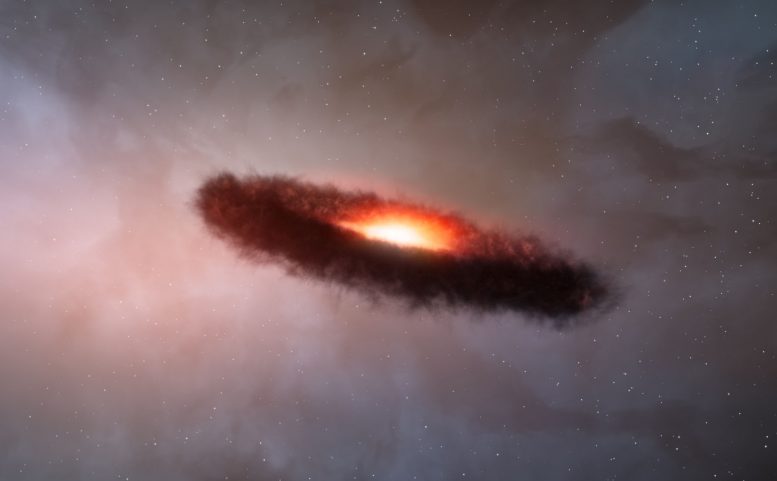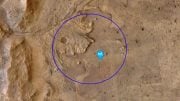
This artist’s impression shows the disc of gas and cosmic dust around a brown dwarf. Rocky planets are thought to form through the random collision and sticking together of what are initially microscopic particles in the disc of material around a star. These tiny grains, known as cosmic dust, are similar to very fine soot or sand. Astronomers using the Atacama Large Millimeter/submillimeter Array (ALMA) have for the first time found that the outer region of a dusty disc encircling a brown dwarf — a star-like object, but one too small to shine brightly like a star — also contains millimeter-sized solid grains like those found in denser discs around newborn stars. The surprising finding challenges theories of how rocky, Earth-scale planets form, and suggests that rocky planets may be even more common in the Universe than expected. Credit: ALMA (ESO/NAOJ/NRAO)/M. Kornmesser (ESO)
While viewing the young brown dwarf ISO-Oph 102, an international team of astronomers pinpointed carbon monoxide gas around the brown dwarf and found that the outer region of the dusty disc encircling the brown dwarf contains millimeter-sized solid grains.
Astronomers using the Atacama Large Millimeter/submillimeter Array (ALMA) have for the first time found that the outer region of a dusty disc encircling a brown dwarf contains millimeter-sized solid grains like those found in denser discs around newborn stars. The surprising finding challenges theories of how rocky, Earth-scale planets form, and suggests that rocky planets may be even more common in the Universe than expected. The research paper is printed in the Astrophysical Journal Letters.
Rocky planets are thought to form through the random collision and sticking together of what are initially microscopic particles in the disc of material around a star. These tiny grains, known as cosmic dust, are similar to very fine soot or sand. However, in the outer regions around a brown dwarf — a star-like object, but one too small to shine brightly like a star — astronomers expected that grains could not grow because the discs were too sparse, and particles would be moving too fast to stick together after colliding. Also, prevailing theories say that any grains that manage to form should move quickly toward the central brown dwarf, disappearing from the outer parts of the disc where they could be detected.
“We were completely surprised to find millimeter-sized grains in this thin little disc,” said Luca Ricci of the California Institute of Technology, USA, who led a team of astronomers based in the United States, Europe, and Chile. “Solid grains of that size shouldn’t be able to form in the cold outer regions of a disc around a brown dwarf, but it appears that they do. We can’t be sure if a whole rocky planet could develop there, or already has, but we’re seeing the first steps, so we’re going to have to change our assumptions about conditions required for solids to grow,” he said.
This video starts with a broad panorama of the spectacular central regions of the Milky Way seen in visible light. It zooms in to the Rho Ophiuchi star-forming region, to the brown dwarf ISO-Oph 102, or Rho-Oph 102. Then, an artist’s impression shows the disc of material around the brown dwarf, and zooms in to show how tiny grains collide and stick together, to form large grains. Credit: ALMA (ESO/NAOJ/NRAO)/L. Calçada (ESO)/M. Kornmesser (ESO)/Nick Risinger (skysurvey.org)/Digitized Sky Survey 2 Music: movetwo
ALMA’s increased resolution compared to previous telescopes also allowed the team to pinpoint carbon monoxide gas around the brown dwarf — the first time that cold molecular gas has been detected in such a disc. This discovery, and that of the millimeter-size grains, suggest that the disc is much more similar to the ones around young stars than previously expected.
Ricci and his colleagues made their findings using the partially completed ALMA telescope in the high-altitude Chilean desert. ALMA is a growing collection of high-precision, dish-shaped antennas that work together as one large telescope to observe the Universe with groundbreaking detail and sensitivity. ALMA “sees” the Universe in millimeter-wavelength light, which is invisible to human eyes. Construction of ALMA is scheduled to finish in 2013, but astronomers began observing with a partial array of ALMA dishes in 2011.
The astronomers pointed ALMA at the young brown dwarf ISO-Oph 102, also known as Rho-Oph 102, in the Rho Ophiuchi star-forming region in the constellation of Ophiuchus (The Serpent Bearer). With about 60 times the mass of Jupiter but only 0.06 times that of the Sun, the brown dwarf has too little mass to ignite the thermonuclear reactions by which ordinary stars shine. However, it emits heat released by its slow gravitational contraction and shines with a reddish color, albeit much less brightly than a star.
ALMA collected light with wavelengths around a millimeter, emitted by disc material warmed by the brown dwarf. The grains in the disc do not emit much radiation at wavelengths longer than their own size, so a characteristic drop-off in the brightness can be measured at longer wavelengths. ALMA is an ideal instrument for measuring this drop-off and thus for sizing up the grains. The astronomers compared the brightness of the disc at wavelengths of 0.89 mm and 3.2 mm. The drop-off in brightness from 0.89 mm to 3.2 mm was not as steep as expected, showing that at least some of the grains are a millimeter or more in size.
“ALMA is a powerful new tool for solving mysteries of planetary system formation,” commented Leonardo Testi from ESO, a member of the research team. “Trying this with previous generation telescopes would have needed almost a month of observing — impossibly long in practice. But, using just a quarter of ALMA’s final complement of antennas, we were able to do it in less than one hour!” he said.
In the near future, the completed ALMA telescope will be powerful enough to make detailed images of the discs around Rho-Oph 102 and other objects. Ricci explained, “We will soon be able to not only detect the presence of small particles in discs, but to map how they are spread across the circumstellar disc and how they interact with the gas that we’ve also detected in the disc. This will help us better understand how planets come to be.”
Reference: “ALMA Observations of ρ-Oph 102: Grain Growth and Molecular Gas in the Disk around a Young Brown Dwarf” by L. Ricci, L. Testi, A. Natta, A. Scholz and I. de Gregorio-Monsalvo, 30 November 2012, The Astrophysical Journal Letters.
DOI: 10.1088/2041-8205/761/2/L20









SCIENCE SHOWS THAT THE UNIVERSE CANNOT BE ETERNAL because it could not have sustained itself eternally due to the law of entropy (increasing energy decay, even in an open system). Einstein showed that space, matter, and time all are physical and all had a beginning. Space even produces particles because it’s actually something, not nothing. Even time had a beginning! Time is not eternal. Popular atheistic scientist Stephen Hawking admits that the universe came from nothing but he believes that nothing became something by a natural process yet to be discovered. That’s not rational thinking at all, and it also would be making the effect greater than its cause to say that nothing created something. The beginning had to be of supernatural origin because natural laws and processes do not have the ability to bring something into existence from nothing. What about the Higgs boson (the so-called “God Particle”)? The Higgs boson does not create mass from nothing, but rather it converts energy into mass. Einstein showed that all matter is some form of energy.
The supernatural cannot be proved by science but science points to a supernatural intelligence and power for the origin and order of the universe. Where did God come from? Obviously, unlike the universe, God’s nature doesn’t require a beginning.
EXPLAINING HOW AN AIRPLANE WORKS doesn’t mean no one made the airplane. Explaining how life or the universe works doesn’t mean there was no Maker behind them. Natural laws may explain how the order in the universe works and operates, but mere undirected natural laws cannot explain the origin of that order. Once you have a complete and living cell then the genetic code and biological machinery exist to direct the formation of more cells, but how could life or the cell have naturally originated when no directing code and mechanisms existed in nature? Read my Internet article: HOW FORENSIC SCIENCE REFUTES ATHEISM.
WHAT IS SCIENCE? Science simply is knowledge based on observation. No one observed the universe coming by chance or by design, by creation or by evolution. These are positions of faith. The issue is which faith the scientific evidence best supports.
Visit my newest Internet site: THE SCIENCE SUPPORTING CREATION
Babu G. Ranganathan*
(B.A. Bible/Biology)
Author of popular Internet article, TRADITIONAL DOCTRINE OF HELL EVOLVED FROM GREEK ROOTS
*I have given successful lectures (with question and answer period afterwards) defending creation before evolutionist science faculty and students at various colleges and universities. I’ve been privileged to be recognized in the 24th edition of Marquis “Who’s Who in The East” for my writings on religion and science.